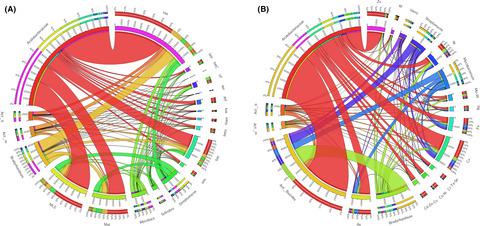当前位置:
X-MOL 学术
›
Microb. Biotechnol.
›
论文详情
Our official English website, www.x-mol.net, welcomes your feedback! (Note: you will need to create a separate account there.)
Co-occurrence of antibiotic, biocide, and heavy metal resistance genes in bacteria from metal and radionuclide contaminated soils at the Savannah River Site.
Microbial Biotechnology ( IF 5.7 ) Pub Date : 2020-05-03 , DOI: 10.1111/1751-7915.13578 Jesse C Thomas 1 , Adelumola Oladeinde 2 , Troy J Kieran 1 , John W Finger 3 , Natalia J Bayona-Vásquez 1, 4 , John C Cartee 5 , James C Beasley 6, 7 , John C Seaman 6 , J Vuan McArthur 6 , Olin E Rhodes 6, 8 , Travis C Glenn 1, 4
Microbial Biotechnology ( IF 5.7 ) Pub Date : 2020-05-03 , DOI: 10.1111/1751-7915.13578 Jesse C Thomas 1 , Adelumola Oladeinde 2 , Troy J Kieran 1 , John W Finger 3 , Natalia J Bayona-Vásquez 1, 4 , John C Cartee 5 , James C Beasley 6, 7 , John C Seaman 6 , J Vuan McArthur 6 , Olin E Rhodes 6, 8 , Travis C Glenn 1, 4
Affiliation

|
Contaminants such as heavy metals may contribute to the dissemination of antimicrobial resistance (AMR) by enriching resistance gene determinants via co‐selection mechanisms. In the present study, a survey was performed on soils collected from four areas at the Savannah River Site (SRS), South Carolina, USA, with varying contaminant profiles: relatively pristine (Upper Three Runs), heavy metals (Ash Basins), radionuclides (Pond B) and heavy metal and radionuclides (Tim’s Branch). Using 16S rRNA gene amplicon sequencing, we explored the structure and diversity of soil bacterial communities. Sites with legacies of metal and/or radionuclide contamination displayed significantly lower bacterial diversity compared to the reference site. Metagenomic analysis indicated that multidrug and vancomycin antibiotic resistance genes (ARGs) and metal resistance genes (MRGs) including those associated with copper, arsenic, iron, nickel and zinc were prominent in all soils including the reference site. However, significant differences were found in the relative abundance and diversity of certain ARGs and MRGs in soils with metal/radionuclide contaminated soils compared to the reference site. Co‐occurrence patterns revealed significant ARG/MRG subtypes in predominant soil taxa including Acidobacteriaceae, Bradyrhizobium, Mycobacterium, Streptomyces, Verrumicrobium, Actinomadura and Solirubacterales. Overall, the study emphasizes the potential risk of human activities on the dissemination of AMR in the environment.
中文翻译:

萨凡纳河站点的金属和放射性核素污染土壤中的细菌中同时存在抗生素,杀生物剂和重金属抗性基因。
诸如重金属之类的污染物可能会通过共选机制丰富抗药性基因决定因素,从而有助于传播抗药性(AMR)。在本研究中,对从美国南卡罗来纳州萨凡纳河站点(SRS)的四个区域收集的土壤进行了调查,这些土壤具有不同的污染物特征:相对原始的(上部三次),重金属(阿什盆地),放射性核素(池塘B)和重金属和放射性核素(蒂姆斯分公司)。使用16S rRNA基因扩增子测序,我们探索了土壤细菌群落的结构和多样性。与参考部位相比,具有金属和/或放射性核素污染遗留的部位显示出明显更低的细菌多样性。荟萃基因组分析表明,在包括参考点在内的所有土壤中,包括与铜,砷,铁,镍和锌相关的基因在内的多药和万古霉素抗生素抗性基因(ARG)和金属抗性基因(MRG)均很突出。然而,与参考地点相比,在金属/放射性核素污染的土壤中,某些ARG和MRG的相对丰度和多样性存在显着差异。共现模式揭示了主要土壤分类中的重要ARG / MRG亚型,包括 与参考地点相比,在金属/放射性核素污染的土壤中,某些ARG和MRG的相对丰度和多样性存在显着差异。共现模式揭示了主要土壤分类中的重要ARG / MRG亚型,包括 与参考地点相比,在金属/放射性核素污染的土壤中,某些ARG和MRG的相对丰度和多样性存在显着差异。共现模式揭示了主要土壤分类中的重要ARG / MRG亚型,包括Acidobacteriaceae,慢生,分枝杆菌,霉菌,Verrumicrobium,马杜拉放线菌属和Solirubacterales。总的来说,该研究强调了人类活动对环境中AMR传播的潜在风险。
更新日期:2020-05-03
中文翻译:

萨凡纳河站点的金属和放射性核素污染土壤中的细菌中同时存在抗生素,杀生物剂和重金属抗性基因。
诸如重金属之类的污染物可能会通过共选机制丰富抗药性基因决定因素,从而有助于传播抗药性(AMR)。在本研究中,对从美国南卡罗来纳州萨凡纳河站点(SRS)的四个区域收集的土壤进行了调查,这些土壤具有不同的污染物特征:相对原始的(上部三次),重金属(阿什盆地),放射性核素(池塘B)和重金属和放射性核素(蒂姆斯分公司)。使用16S rRNA基因扩增子测序,我们探索了土壤细菌群落的结构和多样性。与参考部位相比,具有金属和/或放射性核素污染遗留的部位显示出明显更低的细菌多样性。荟萃基因组分析表明,在包括参考点在内的所有土壤中,包括与铜,砷,铁,镍和锌相关的基因在内的多药和万古霉素抗生素抗性基因(ARG)和金属抗性基因(MRG)均很突出。然而,与参考地点相比,在金属/放射性核素污染的土壤中,某些ARG和MRG的相对丰度和多样性存在显着差异。共现模式揭示了主要土壤分类中的重要ARG / MRG亚型,包括 与参考地点相比,在金属/放射性核素污染的土壤中,某些ARG和MRG的相对丰度和多样性存在显着差异。共现模式揭示了主要土壤分类中的重要ARG / MRG亚型,包括 与参考地点相比,在金属/放射性核素污染的土壤中,某些ARG和MRG的相对丰度和多样性存在显着差异。共现模式揭示了主要土壤分类中的重要ARG / MRG亚型,包括Acidobacteriaceae,慢生,分枝杆菌,霉菌,Verrumicrobium,马杜拉放线菌属和Solirubacterales。总的来说,该研究强调了人类活动对环境中AMR传播的潜在风险。



























 京公网安备 11010802027423号
京公网安备 11010802027423号